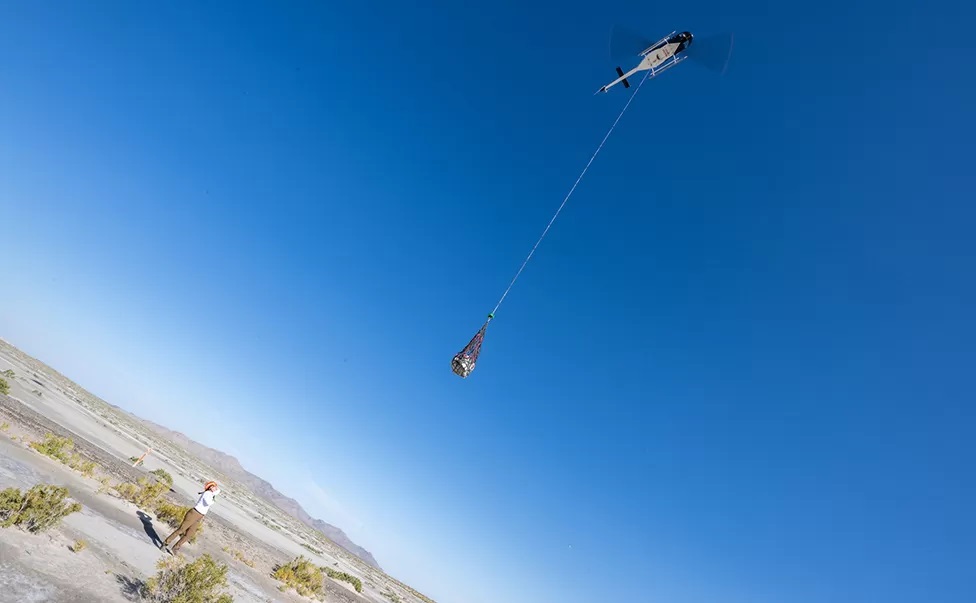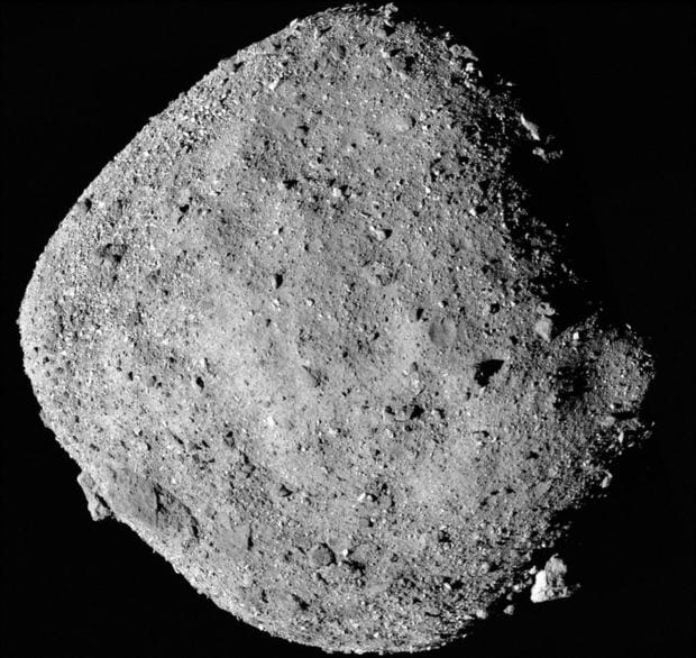
NASA landed the dusty samples from asteroid Bennu described as the “most dangerous known rock in the Solar System” in the West Desert of Utah state on Sunday.
The samples had been scooped up from the surface of asteroid Bennu in 2020 by the Osiris-Rex spacecraft.
The American space agency wants to learn more about the mountainous object, not least because it has an outside chance of hitting our planet in the next 300 years.
They could also provide fresh insights into the formation of the Solar System 4.6 billion years ago and possibly even how life got started on Earth.
NASA: touchdown from asteroid Bennu was like a feather
Touchdown on desert land belonging to the Department of Defense was confirmed at 08:52 local time, three minutes ahead of schedule.
The car-tyre-sized container had come screaming into the atmosphere over the western US at more than 12km/s (27,000mph). A heatshield and parachutes slowed its descent and dropped it gently, perfectly onto restricted ground.
“This little capsule understood the assignment,” said Tim Priser, the chief engineer at aerospace manufacturer Lockheed Martin. “It touched down like a feather.”
“I cried like a baby in that helicopter when I heard that the parachute had opened and we were coming in for a soft landing,” said Osiris-Rex principal investigator Dante Lauretta.
“It was just an overwhelming moment for me. It’s an astounding accomplishment.”
Scientists are eager to get their hands on the precious cargo which pre-landing estimates put at some 250 grams (9oz).
That might not sound like very much – the weight of an adult hamster, as one scientist described it – but for the types of tests NASA teams want to do, it is more than ample.
“We can analyse at a very high resolution very small particles,” said Eileen Stansbery, the chief scientist at Nasa’s Johnson Space Center in Texas.
“We know how to slice and dice a 10 micron-sized particle into a dozen slices and to then map grain by grain at nano scales. So, 250 grams is huge.”
10 reasons NASA thinks asteroid Bennu is important

According to NASA, the Bennu mission is very important for the following reasons.
1. It’s close to Earth
Unlike most other asteroids that circle the Sun in the asteroid belt between Mars and Jupiter, Bennu’s orbit is close in proximity to Earth’s, even crossing it. The asteroid makes its closest approach to Earth every 6 years.
2. It’s the right size
Asteroids spin on their axes just like Earth does. Small ones, with diameters of 200 meters or less, often spin very fast, up to a few revolutions per minute. This rapid spinning makes it difficult for a spacecraft to touch down and collect samples.
3. It’s really old
Bennu is a leftover fragment from the tumultuous formation of the solar system. Some of the mineral fragments inside Bennu could be older than the solar system. These microscopic grains of dust could be the same ones that spewed from dying stars and eventually coalesced to make the Sun and its planets nearly 4.6 billion years ago.
4. It’s well preserved
Bennu is a time capsule from the early solar system, having been preserved in the vacuum of space. Although scientists think it broke off a larger asteroid in the asteroid belt in a catastrophic collision between about 1 and 2 billion years ago, they don’t expect that these events significantly altered it.
5. It might contain clues to the origin of life
Samples of Bennu will help planetary scientists better understand the role asteroids may have played in delivering life-forming compounds to Earth. We know it is carbon-rich. Carbon is the hinge upon which organic molecules hang.
6. It contains valuable materials
Besides teaching us about our cosmic past, exploring Bennu close-up will help humans plan for the future. Asteroids are rich in natural resources, such as iron and aluminum, and precious metals, such as platinum.
7. It will help us better understand other asteroids
Astronomers have studied Bennu from Earth since it was discovered in 1999. As a result, they think they know a lot about the asteroid’s physical and chemical properties. Their knowledge is based not only on looking at the asteroid, but also studying meteorites found on Earth.
8. It will help us better understand a quirky solar force …
Astronomers have calculated that Bennu’s orbit has drifted about 280 meters (0.18 miles) per year toward the Sun since it was discovered. This could be because of a phenomenon called the Yarkovsky effect, a process whereby sunlight warms one side of a small, dark asteroid and then radiates as heat off the asteroid as it rotates.
9. … and to keep asteroids at bay
One reason scientists are eager to predict the directions asteroids are drifting is to know when they’re coming too-close-for-comfort to Earth.
10. It’s a gift that will keep on giving
Samples of Bennu will return to Earth on September 24, 2023. OSIRIS-REx scientists will study a quarter of the regolith. The rest will be made available to scientists around the globe, and also saved for those not yet born, using techniques not yet invented, to answer questions not yet asked.
See all the latest news from Greece and the world at Greekreporter.com. Contact our newsroom to report an update or send your story, photos and videos. Follow GR on Google News and subscribe here to our daily email!



